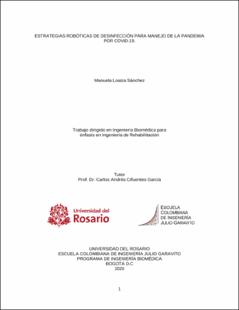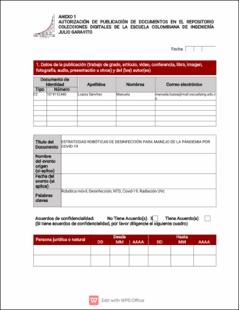Mostrar el registro sencillo del ítem
Estrategias robóticas de desinfección para manejo de la pandemia por COVID - 19
Robotic disinfection strategies for covid-19 pandemic management
| dc.contributor.author | Loaiza Sánchez, Manuela | |
| dc.date.accessioned | 2021-12-16T02:07:29Z | |
| dc.date.available | 2021-12-16T02:07:29Z | |
| dc.date.issued | 2021 | |
| dc.identifier.uri | https://repositorio.escuelaing.edu.co/handle/001/1923 | |
| dc.description.abstract | Al buscar una posible solución o mejora para la calidad de vida de las personas durante esta emergencia global, se le ha abierto la oportunidad a la robótica e inteligencia artificial de surgir exponencialmente; siendo evidenciada en estudios de implementación robótica. Se han implementado métodos de salas automatizadas sin contacto durante la desinfección o en inglés conocido como no-touch disinfection system (NTD), ya que estas permiten una desinfección eficaz y fiable de la contaminación superficial del espacio. Para dar otra solución a esta problemática de desinfección de espacios durante la pandemia por el COVID-19, de la mano del semillero de rehabilitación y el centro de Biomecánica de la Escuela Colombiana Julio Garavito, a través del proyecto COVIBOT del 2020-2021, se propone implementar un robot automatizado haciendo uso de radicación de luz ultravioleta-C para la desinfección de los espacios de la universidad, haciendo un control monitoreado remotamente durante la desinfección, implementando a su vez sensores de UV y sensores de movimiento para garantizar que no haya personas dentro del espacio que se esté desinfectando. | spa |
| dc.description.abstract | In searching for a possible solution or improvement for people's quality of life during this global emergency, robotics and artificial intelligence have been given the opportunity to emerge exponentially, as evidenced in robotic implementation studies. Automated no-touch disinfection system (NTD) methods have been implemented, as they allow effective and reliable disinfection of surface contamination of the space. To provide another solution to this problem of disinfection of spaces during the pandemic by COVID-19, in collaboration with the rehabilitation seedbed and the center of Biomechanics of the Escuela Colombiana Julio Garavito, through the COVIBOT project of 2020-2021, it is proposed to implement an automated robot making the disinfection of spaces during the pandemic by COVID-19, using ultraviolet-C light radiation for the disinfection of the spaces of the university, making a remotely monitored control during disinfection, implementing UV sensors and motion sensors to ensure that there are no people inside the space being disinfected. | eng |
| dc.format.extent | 26 páginas | spa |
| dc.format.mimetype | application/pdf | spa |
| dc.language.iso | spa | spa |
| dc.title | Estrategias robóticas de desinfección para manejo de la pandemia por COVID - 19 | spa |
| dc.title | Robotic disinfection strategies for covid-19 pandemic management | eng |
| dc.title.alternative | Robotic disinfection strategies for covid-19 pandemic management | eng |
| dc.type | Documento de trabajo | spa |
| dcterms.audience | Estudiantes, profesores, comunidad científica colombiana | spa |
| dc.type.version | info:eu-repo/semantics/submittedVersion | spa |
| oaire.accessrights | http://purl.org/coar/access_right/c_14cb | spa |
| oaire.awardtitle | Proyecto Covibot | spa |
| oaire.version | http://purl.org/coar/version/c_970fb48d4fbd8a85 | spa |
| dc.contributor.researchgroup | Centro de biomecatrónica | spa |
| dc.contributor.researchgroup | Semillero de Rehabilitación | spa |
| dc.description.researcharea | Ingeniería de Rehabilitación | spa |
| dc.identifier.instname | Escuela Colombiana de Ingeniería Julio Garavito | spa |
| dc.publisher.place | Bogotá, Colombia | spa |
| dc.relation.references | [1] Organización Panamericana de la Salud/Organización Mundial de la Salud. “Actualización Epidemiológica: Nuevo coronavirus (COVID-19)”, 2020. [2] S. Fong, N. Dey, and J. Chaki, “An Introduction to COVID-19”, Artificial Intelligence for Coronavirus Outbreak, pp. 1–22, 2020. [3] A. Begic, “Application of Service Robots for Disinfection in Medical Institutions”, Advanced Technologies, Systems, and Applications II: Proceedings of the International Symposium on Innovative and Interdisciplinary Applications of Advanced Technologies (IAT), vol. 28, pp. 1056– 1065, 2017. [4] S. Fong, N. Dey, and J. Chaki, “AI-Enabled Technologies that Fight the Coronavirus Out break”, Artificial Intelligence for Coronavirus Outbreak, pp. 23–45, 2020. [5] Z. Khan, A. Siddique, and C. Lee, “Robotics Utilization for Healthcare Digitization in Global COVID-19 Management”, International journal of environmental research and public health, vol. 17, n. 11, 2020. [6] Q. Ye, J. Zhou, and H. Wu, “Using Information Technology to Manage the COVID-19 Pandemic: Development of a Technical Framework Based on Practical Experience in China”, JMIR medical informatics, vol. 8, n.6, e19515, 2020. [7] J. Otter, S. Yezli, F. Barbut, and T. Perl, “An overview of automated room disinfection systems: When to use them and how to choose them”, Decontamination in Hospitals and Healthcare, pp. 323–369, 2020. [8] J. Otter, S. Yezli, T. Perl, F. Barbut, and G. French, “The role of ‘no-touchautomated room disinfection systems in infection prevention and control”, Journal of Hospital Infection, vol. 83, n.1, pp.1–13, 2013. [9] J. Otter, S. Yezli, T. Perl, F. Barbut, and G. French, “A guide to no-touch automated room disinfection (NTD) systems”, Decontamination in Hospitals and Healthcare, pp. 413–460, 2014. [10] C. Rock, B. Small, K. Thom, and For the C D C Prevention Epicenters Program. “Innovative Methods of Hospital Disinfection in Prevention of Healthcare Associated Infections”, Current Treatment Options in Infectious Diseases, vol. 10, n. 1, pp. 65–77, 2018. [11] P. Tarka and A. Nitsch-Osuch, “No-Touch Automated Disinfection System for Decontamination of Surfaces in Hospitals”, International journal of environmental research and public health, vol. 17, n.14, pp. 5131, 2020. [12] D. Weber, W. Rutala, D. Anderson, L. Chen, E. Sickbert-Bennett, and J. Boyce, “Effectiveness of ultraviolet devices and hydrogen peroxide systems for terminal room decontamination: Focus on clinical trials”, American journal of infection control, vol. 44, n. 5, pp. e77–e84, 2016. [13] D. Weber, H. Kanamori, and W. Rutala, “’No touch’ technologies for environmental decontamination: focus on ultraviolet devices and hydrogen peroxide systems”, vol. 29, n. 4, 2016. [14] C. Blazejewski, F. Wallet, A. Rouze, R. Guern, S. Ponthieux, J. Salleron, and S. Nseir, “Efficiency of hydrogen peroxide in improving disinfection of ICU rooms”, Critical care, vol. 19, n. 1, pp. 30, 2015. [15] S. Lemmen, S. Scheithauer, H. Hafner, S. Yezli, M. Mohr, and J. Otter, “Evaluation of hydrogen peroxide vapor for the inactivation of nosocomial pathogens on porous and nonporous surfaces”, AJIC: American Journal of Infection Control, vol. 43, n. 1, pp. 82– 85, 2015. [16] M. Spencer, M. Vignari, E. Bryce, H. Johnson, L. Fauerbach, and D. Graham, “A model for choosing an automated ultraviolet-C disinfection system and building a case for the C suite: Two case reports”, AJIC: American Journal of Infection Control, vol. 45, n. 3, pp. 288– 292, 2017. [17] B. Casini, B. Tuvo, M. Cristina, A. Spagnolo, M. Totaro, A. Baggiani, and G. Privitera, “Evaluation of an Ultraviolet C (UVC) Light-Emitting Device for Disinfection of High Touch Surfaces in Hospital Critical Areas”, International journal of environmental research and public health, vol. 16, n. 19, pp. 3572, 2019. [18] J. Schaffzin, A. Wilhite, Z. Li, D. Finney, A. Ankrum, and R. Moore, “Maximizing efficiency in a high occupancy setting to utilize ultraviolet disinfection for isolation rooms”, AJIC: American Journal of Infection Control, vol. 48, n. 8, pp. 903–909, 2020. [19] J. Zeber, J. Coppin, F. Villamaria, M. Williams, P. Chatterjee, H. Choi, L. Copeland, and C. Jinadatha, “Use of ultraviolet irradiation in addition to commonly used hospital disinfectants or cleaners further reduces the bioburden on high-touch surfaces”, Open Forum Infectious Diseases, vol. 6, n. 12, 2019. [20] JH. Yang, UI. Wu, HM. Tai, and WH. Sheng, “Effectiveness of an ultraviolet-C disinfection system for reduction of healthcare-associated pathogens”, Journal of Microbiology, Immunology and Infection, vol. 52, n. 3, pp. 487-493, 2019. [21] C. Kovach, Y. Taneli, T. Neiman, E. Dyer, A. Arzaga, and S. Kelber, “Evaluation of an ultraviolet room disinfection protocol to decrease nursing home microbial burden, infection and hospitalization rates”, BMC infectious diseases, vol. 17, n. 1, pp. 186, 2017. [22] N. Mahida, N. Vaughan, and T. Boswell, “First UK evaluation of an automated ultraviolet-C room decontamination device (Tru-DTM)”, Journal of Hospital Infection, vol. 84, n. 4, pp. 332–335, 2013. [23] K. Bedell, A. Buchaklian, and S. Perlman, “Efficacy of an Automated Multiple Emitter Whole-Room Ultraviolet-C Disinfection System Against Coronaviruses MHV and MERS CoV”, Infection control and hospital epidemiology, vol. 37, n. 5, pp. 598–599, 2016. [24] D. Mackenzie, “Ultraviolet Light Fights New Virus”, Engineering, vol. 6, n. 8, pp. 851– 853, 2020. [25] A. Akobeng, “Principles of evidence based medicine”, Arch Dis Child, vol. 90, pp. 837– 840, 2005. [26] Proteger I.P.S, “Luxómetro como Funciona”. [27] Intellego Technologies, “UVC Dosimeter”. [28] M. Lindblad, E. Tano, C. Lindahl and F. Huss, “Ultraviolet-C decontamination of a hospital room: Amount of UV light needed”, Burns, vol. 46, n. 4, pp. 842-849, 2020. | spa |
| dc.rights.accessrights | info:eu-repo/semantics/closedAccess | spa |
| dc.subject.armarc | Pandemias | spa |
| dc.subject.armarc | Pandemics | spa |
| dc.subject.armarc | Inteligencia artificial | spa |
| dc.subject.armarc | Artificial intelligence | eng |
| dc.subject.armarc | Robots industriales | spa |
| dc.subject.armarc | Robots Industrial | eng |
| dc.subject.proposal | Robótica móvil | spa |
| dc.subject.proposal | Desinfección | spa |
| dc.subject.proposal | NTD | spa |
| dc.subject.proposal | Covid-19 | spa |
| dc.subject.proposal | Radiación UVc | spa |
| dc.subject.proposal | mobile robotics | eng |
| dc.subject.proposal | disinfection | eng |
| dc.subject.proposal | NTD | eng |
| dc.subject.proposal | no-touch disinfection system | eng |
| dc.subject.proposal | covid-19 | eng |
| dc.subject.unesco | Robótica | |
| dc.subject.unesco | Desinfección | |
| dc.subject.unesco | Pandemia | |
| dc.subject.unesco | Radiación ultravioleta | |
| dc.type.coar | http://purl.org/coar/resource_type/c_8042 | spa |
| dc.type.content | Text | spa |
| dc.type.driver | info:eu-repo/semantics/workingPaper | spa |
Ficheros en el ítem
Este ítem aparece en la(s) siguiente(s) colección(ones)
-
AA. Gibiome [38]
Clasificación: A - Convocatoria 2018











